| |
|
| Installations |
| The Kendra campus lends itself
to installations of various kinds. Over the years many artists
have created installations in the different spaces of the
campus. Some of these are permanent, and have become an
integral part of the environment of the Kendra. Further
spaces are available for both permanent and temporary installations. |
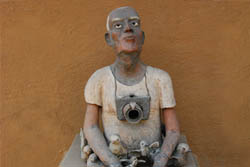
|
Ashokan Poduval,
India
Terracotta 1992
Man with Camera and Birds
Man with eyes looking into infinity, with a camera slung
from his shoulders and small birds sitting on his hand. |
 |
| |
Sui
Jian-guo, China
Stone with Iron Strips 1994
Symbolism of bands constricting one made of metal. Prisoners,
bonded labour, anybody in a situation where they have
no voice or freedom. |
|
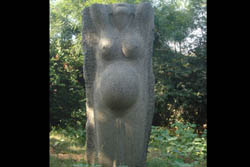
|
Steven Cox,
UK
Granite Stone 1999
Pregnant Woman
Woman looking upward, joy contemplation, happiness in
throwing arms up in the air. Different textures in the
granite. Colour of the sky included in the sculpture -
what does blue sky mean in the context of the sculpture. |
|
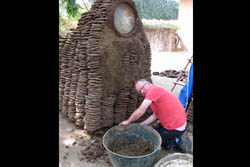
|
Andrew Burton
(U.K.)
2006 - 2007
The theme Andrew works on is loosely based on various
expeditions he has made around the Kendra. “Seemingly
not all that much happens there, but on closer inspection
this place is a kind of microcosm of India. Thousands
of stacks of bricks litter the landscape, and between
these are numerous anthills - rather unworldly structures.
This terrain is also scattered with villages and temples,
numerous cows and dogs. All these will feature, in an
oblique way, in the work.” |
|
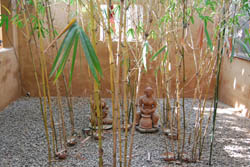
|
Gwyn Hanssen Pigott, Australia
Terracotta 2007 - 2008
The Hope Trail
Gwyn Hanssen Pigott, a visual artist in residence at Sanskriti
Kendra was sponsored by Asialink, Australia. She usually
works with translucent porcelain groupings - parades,
trails and still lifes made up of simple domestic forms,
which have been exhibited worldwide.
Hope Trail is her response to her short time in India.
Installed in a courtyard of the Terracotta Museum, it
celebrates the generosity of the time given on a daily
basis to colour and decoration - and the hope always for
beauty and happiness. The trail will change over time.
The rains will wash some of it away - as the daily garlands
fade, as lives finish. Some, like hope, will stay.
|
|
|
|
Grace Wawa Yang
, Canada/Taiwan
Metal Installation 2009
Yang’s expression artistically stems from an inherent
desire to understand her own existence. She describes
her artistic process as a philosophical investigation
to simultaneously understand life and art itself. She
uses art to express her inner and outer world, and to
represent both her consciousness of the world around her
and her imaginative subconscious. The artist uses various
mediums such as digital photography, light box, and multi-media
installation. |
|
| |
Kris Scholz,
Germany
2009 - 2010
“ My installations and photographs communicate directly
with the stored images which everyone has inside themselves
from their own cultural experiences. These personal influences
and images create our imaginations and dreams.
My latest project relates to the romantic work of Caspar
David Friedrich and my pictures are like his paintings,
pure fiction. The Sanskriti Foundation is supporting me
in photographing the new Metro development and architectural
sites in India such as the Devi Foundation. I will use
these pictures in my new series.” |
|
|
|
Pritika Chowdhry,
USA
2010 - 2011
“My project at Sanskriti explores the communal riots
that have happened in India since 1947, through dharapatras,
which are copper pots with a spouted bottom. Dharapatras
are used in Hindu temples to complete various rituals
of worship, as well as in Ayurveda practices. Seventeen
dharapatras have been etched with details of various communal
riots. They will be installed in a durational installation
with water dripping out of the bottom of these vessels.
I am appropriating the dharapatras as objects loaded with
ritual significance, and reinscribing them as containers
of history that incessantly leak the memories of these
events into the present day.” |
|
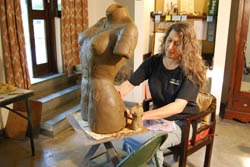
|
Cynthia Siegel,
USA
Terracotta Torso 2011 - 2012
“ I focus my ceramic sculpture on the expressive
possibilities of the figure. At its surface, the human
form reflects a mere fraction of the inner journey of
mind and spirit that defines us as human. I like to imagine
what it would be like if elements from this journey manifested
themselves on the surface of the body in tangible form.
Using both nature and culture, I explore the power of
unspoken thought and emotion. At Sanskriti, I continue
to evolve these ideas with reference to my admiration
for the way that gardens are depicted in Indian minature
paintings.” |
|
|
|
Lucia Moure, Switzerland
2011- 2012
Lucia Moure, born in Bogota, Colombia, currently lives
and works in Geneva, Switzerland.
She has been awarded with supporting grants by la Ville
de Geneve, and has exhibited her work in prestigious institutions
of contemporary art in Switzerland. Lucia has also shown
her work in alternative art galleries in Colombia.
|
|
|
|
Vicki McConville, Australia
Krid Kal: Playing with Yesterday as Tomorrow
Part of ‘Essence of Containment’, a studio-based
research PhD project, 2012 - 2013
‘Krid Kal: Playing with Yesterday as Tomorrow’
is an exhibition of works ‘in progress’. The
work was created during Australian artist Vicki McConville’s
residency at Sanskriti Kendra.
The work takes as its inspiration the Sanskriti Museum
collections and combines these with collections the artist
has gathered on her travels in India. In particular, the
small portable vernacular objects and images that have
been handled, travelled and traded over time. These works,
and their reflections, have been animated over time.
The work involves the use of found objects such as kolum/rangoli
stencils, objects from the Museum such as hair combs and
nutcrakers, shadows and projections using light and rice
flour floor drawings. In each of these shadows and projections,
the objects become ‘ephemeral’, just like
the kolum/rangoli. Once the projector light is switched
off, once the rice is swept away, the image disappears.
They explore the transient and ephemeral connection between
past and present.
|
|
|